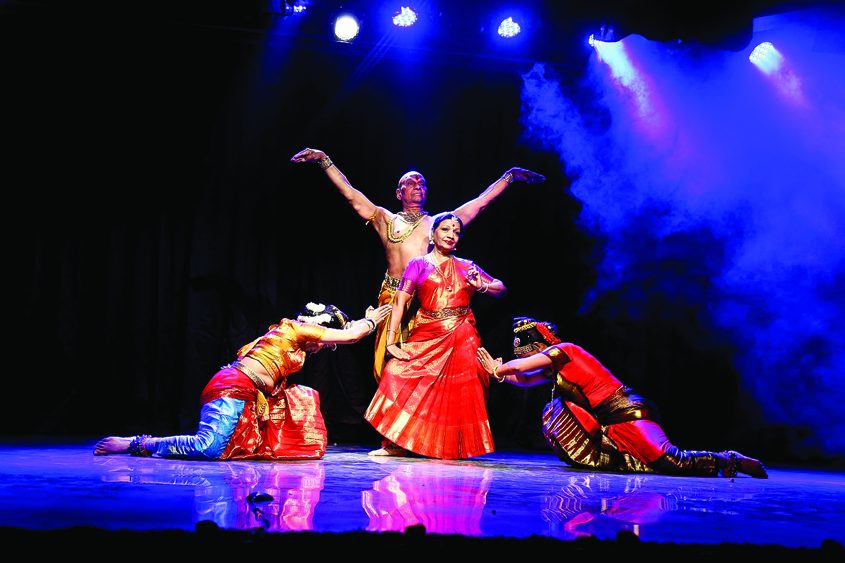The Natya Tarangini performing arts, founded by Raja and Radha Reddy forty years ago, has been organising annually “Parampara Series — The National festival of Music and Dance” to promote Indian dance and music for the last 20 years. This year, on 24 February, Raja and Radha Reddy performed Lasya Tandavam: the lyrical dance of Goddess Parvati and majestic dance of God Shiva, on the occasion of the Mahshivratri concert. They speak to Guardian 20.
Q. Dr Raja, your work in the art of Kuchipudi is now a part of the history of this dance form itself.Gow did you begin your journey?
A. When we came to Delhi for the first time, Kuchipudi was not known at all, other than one or two numbers. When we started our journey as Kuchipudi dancers, it was not easy, since only dances famous then were Kathak and Bharatnatyam; we had to struggle a lot to bring it to the world platform. But once Kuchipudi was established as a dance form, the audience got hooked and appreciative of this art form. The audiences not only thoroughly enjoy but love watching Kuchipudi.
Q. Dr Radha, did your marriage to Dr Raja Reddy determine your involvement in Kuchipudi or had you been practicing this form before your acquaintance with him?
A. Ours was a childhood marriage — when I was five and he was 11 years old. When I married Raja, he was my guru and my partner in dance. With Lord Venkateshawaras’s grace, we became not only soul mates but dance partners for life long.
Q. Dr Raja Reddy, could you please explain, in the simplest way, what the Kuchipudi dance form is about? Share a little bit of Kuchipudi’s history with us.
A. Kuchipudi dance is born from a human being’s most simple movements and imaginative ideas. It is the dance style that engulfs the excitement of storytelling, emotions, drama, movements and rhythm with depth and meaning. It is racy and sprightly —indicating the quest for the conquering of space and time. With all its vigorous and vibrating leaps and turns, it is not cast in the mould of impressionism. It is ebullient, scintillating and yet has a capacity to be intensely lyrical.
Kuchipudi dance is a poetic expression of life’s variegated moods and speaks through manifold rhythmic patterns, melodic gestures and subtle facial expressions, creating a new world of ecstasy and ethereal existence.
India is known for its dance, and through the ages these have developed into a mature classical art form.
As a classical form of dance, drama and music, Kuchipudi enjoys a unique place among the Indian classical dance idioms. Kuchipudi is a complete dance — drama as conceived by Bharata Muni who was the author of Natya Shastra, that dance forms follow, in which conventional and realistic form of acting are happily blended. It is in its subtle, interfusion of drama in an otherwise classical pattern of dance that Kuchipudi displays its uniqueness.
“As a classical form of dance, drama and music, Kuchipudi enjoys a unique place among the Indian classical dance idioms. It is in its subtle, interfusion of drama in an otherwise classical pattern of dance that Kuchipudi displays its uniqueness.”
Q. How did you arrive at the decision of dedicating your life to Kuchipudi and its development?
A. We were mad about dance. My parents wanted me to pursue some career as a doctor or engineer, which used to be considered a respectful job back then. But I had my mind and my heart set on dancing. I was not moulded to do anything but dance. I had passion only for dance, dance and dance.
Q. In this day and age, what is the level of participation in Kuchipudi? Are new generations willing to learn Kuchipudi?
A. The kind of exposure that we have with a lot of modernity and development, we have also adapted to modernity but without meddling with the originality and traditional forms and bringing a freshness to it.
Q. You’ve performed all over the world. Could you tell us about the response of foreign audiences to this cultural form?
A. We have been performing in foreign nations for more than four decades now. They like tradition, the original form of classical dances of India. They are awed by our presentation, our jewellery, our clothes and our colourful presentations. They always study the art and the artist before going for concerts, so that they can understand and appreciate the form. They even wait hours to talk to us in case they want to understand something. They are highly receptive and appreciative of classical Indian art forms, especially Kuchipudi.
Q. What plans do you have in mind for further promotion of Kuchipudi globally?
A. We have set up an institute for dance, the Natya Tarangini Performing Arts Centre, which is imparting knowledge to more and more students. The speciality of this institute is that we teach our students ourselves, which results in not only knowledge but personal grooming and adds quality to what they learn.
Q. What are the essentials that are needed to be a good Kuchipudi dancer?
A. Complete dedication to the dance form. You have to mentally give yourself up to the art. You have to come with an open mind and a dedication to committing yourself wholly with a pure heart. To never think about the fruit it would bear in future. The gains, the success, the fame, and money — everything would follow itself, but you have to be selfless.

